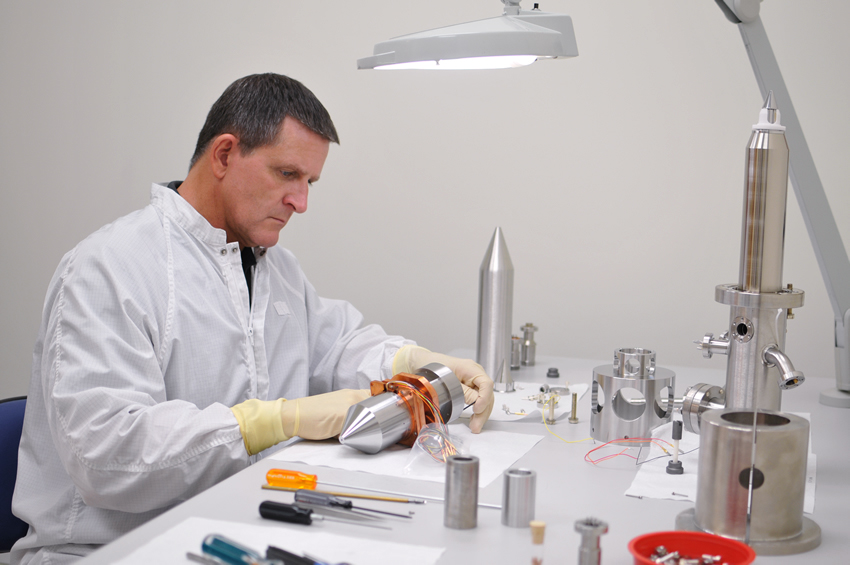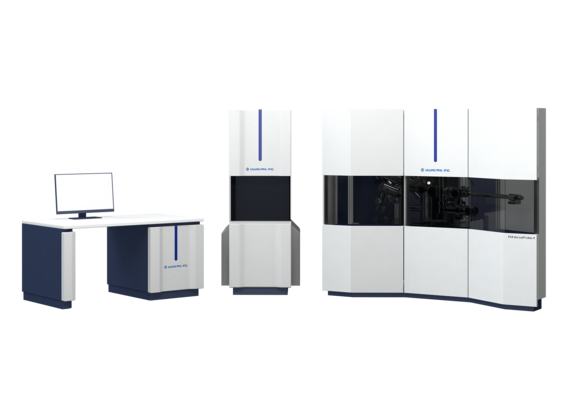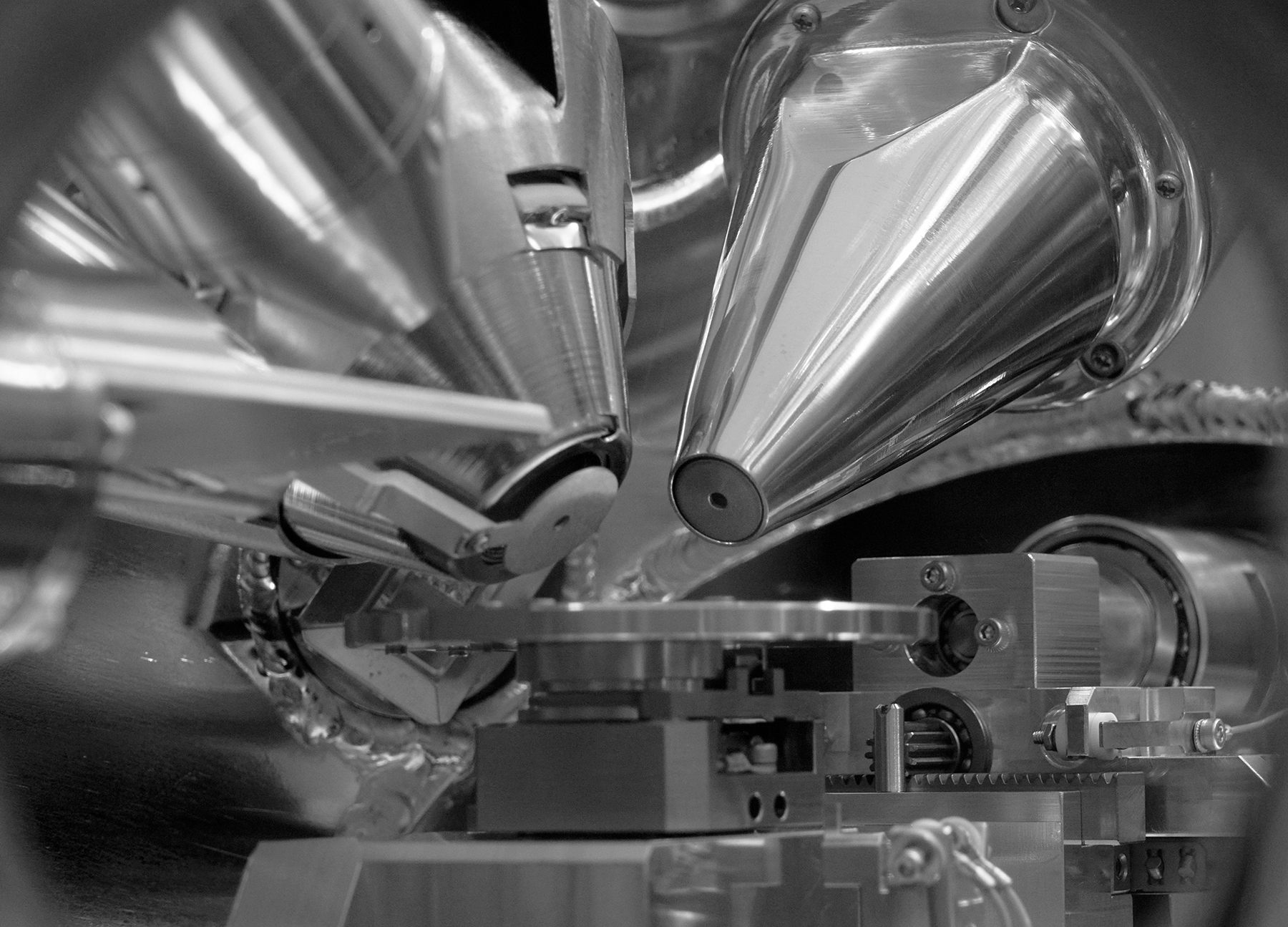The PHI VersaProbe 4 is a highly versatile, multi-technique instrument with PHI’s patented, monochromatic, micro-focused, scanning X-ray source. The instrument offers true SEM-like ease of operation with superior micro area spectroscopy and excellent large area capabilities. The fully integrated multi-technique platform of the PHI VersaProbe 4 offers an array of optional excitation sources, sputter ion sources, and sample treatment and transfer capabilities. These features are essential in studying today’s advanced materials and in supporting your material characterization and problem-solving needs.
The new PHI VersaProbe 4 has improved spectroscopic performance, new large area imaging and mapping capabilities, and environmentally friendly modern configuration with efficient power consumption, faster pump-down and ergonomic design.
Intuitive Sample Navigation And Confident Analysis Area Identification
- The unique scanning X-ray microprobe allows SEM like navigation with point-and-click control
- X-ray induced secondary electron imaging (SXI) provides a perfect correlation between imaged areas and spectroscopy
- NEW X-ray induced Secondary Electron Imaging (SXI) for large-area navigation and large area chemical mapping
Optimized Depth Profiling
- Multiple ion gun options (monatomic Ar, C60, argon cluster GCIB) for a variety of organic, inorganic, and mixed materials
- Full 5-axis stage functionality including rotation/tilt and heating/cooling during sputtering
- Multipoint profiling within a single sputter crater for on/off defect analysis and precious samples
- Adjustable solid collection angle for improved angular resolution for Angle-Resolved analysis with advanced software for high-throughput film structure analysis
Superior Micro-Area Analysis
- Highest small area sensitivity on the market
- <10 microns microprobe size in x and y
- Image registration for unattended automated micro-area analysis
Suite Of Specialized Solutions For In Situ Characterization Of Advanced Materials
- Electronic band structure of organic and inorganic materials using UPS, LEIPS, REELS measurement from the same sample location
- Electrochemical (biasing, polarization studies) experiments
- Inert sample transfer vessel
- Fully integrated high energy and high spatial resolution Auger Spectroscopy with elemental mapping at the exact location of interest as XPS
Capabilities of the PHI VersaProbe 4
Micro-Focused Scanning X-ray Source and SEM-Like Operation
Ease of navigation and operation in SEM-like mode
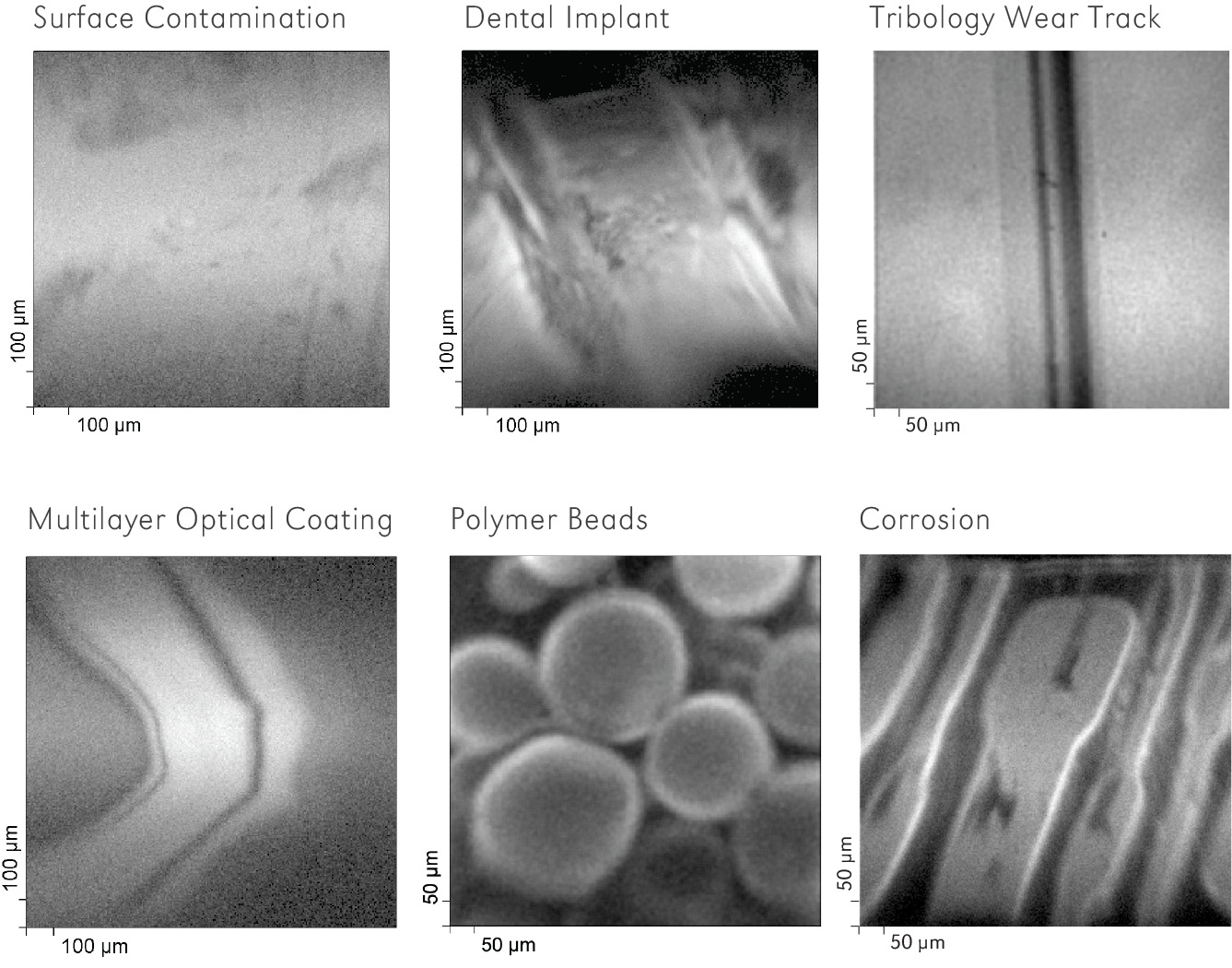
SEM-Like XPS Microprobe
Unique CapabilitiesPHI’s scanning XPS microprobe instrument platform provides scanning X-ray induced secondary electron images (SXI) generated by scanning a focused sub-10 μm X-ray beam across the sample. Just like an SEM, SXI’s can be used to navigate to areas of interest and to select areas for analysis in real time. SXI images provide 100% confidence in locating small features of interest and in avoiding areas with contamination and inhomogeneities for analysis. SXI images have a contrast mechanism that is dominated by photoelectron yield (composition), and therefore often reveal features that are not optically visible or related to topography.
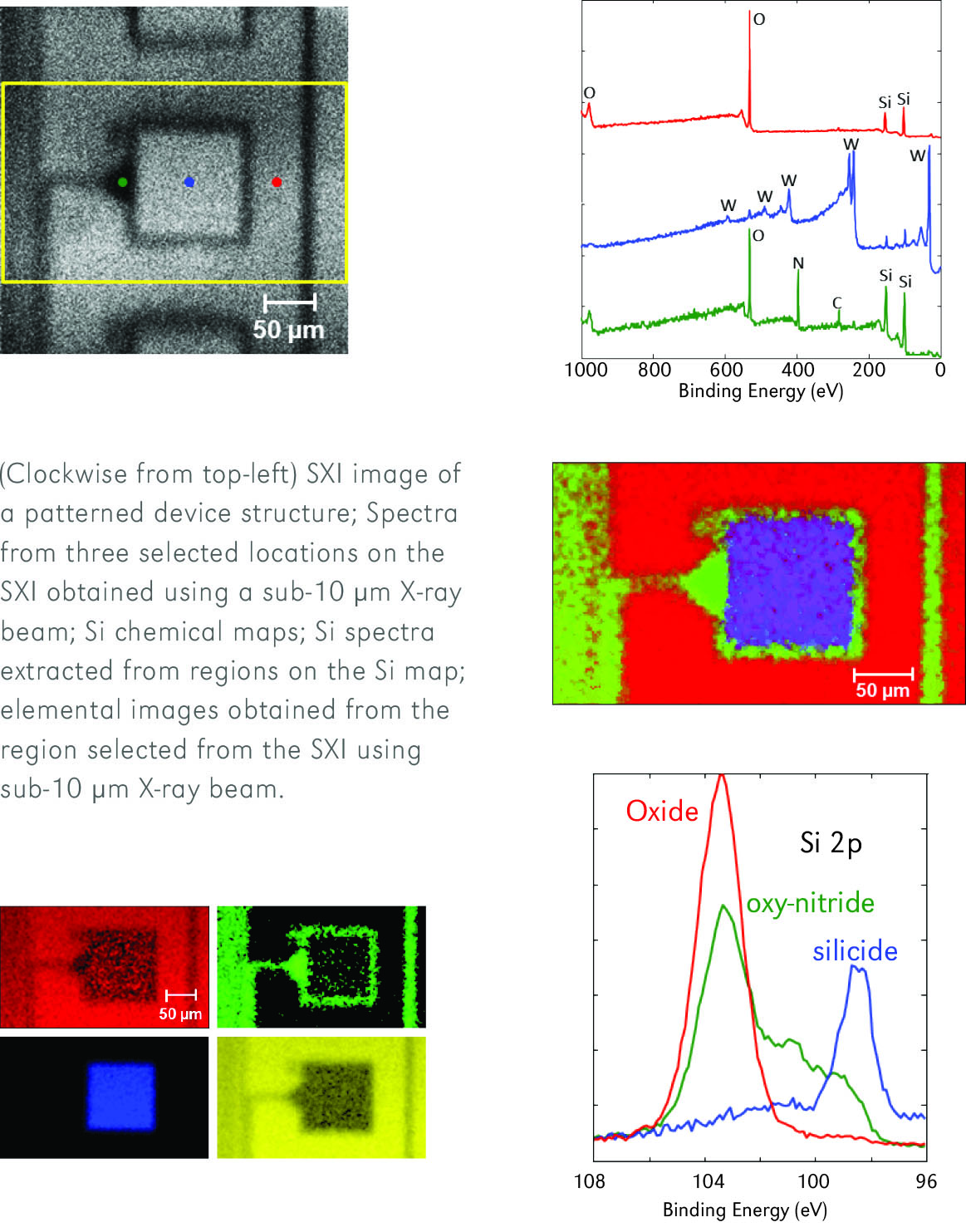
SEM-Like Operation
SEM-Like WorkflowA typical XPS analysis on the PHI VersaProbe 4 begins by collecting an SXI image that is quickly generated using a sub-10 μm diameter raster scanned X-ray beam. Areas of interest for small or large spectral analysis or imaging are used to guide the next steps which may include: obtaining high energy resolution spectra for chemical state analysis, chemical state images, or compositional sputter depth profiles.
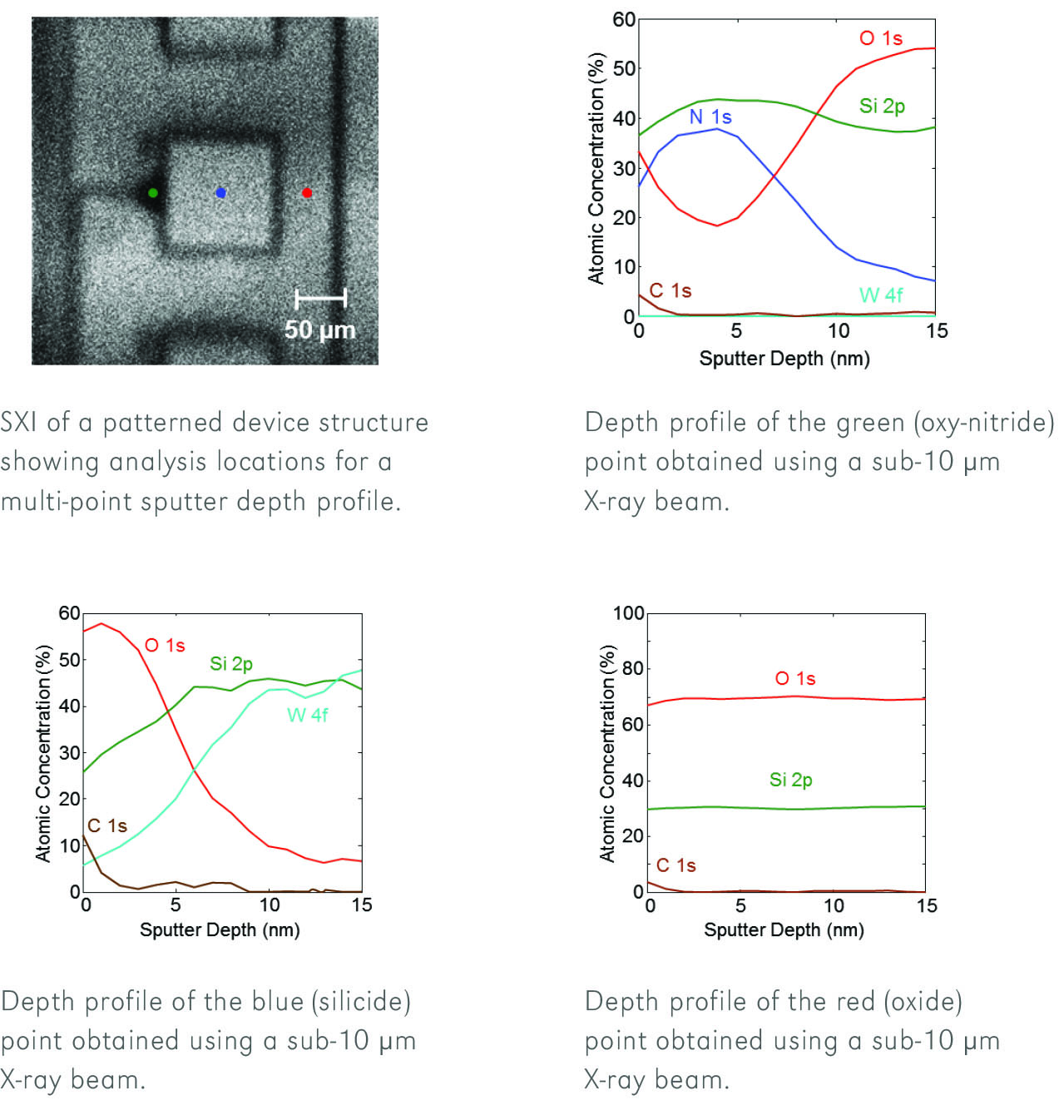
Single Crater Multi-Point Depth Profiling
A powerful capability enabled by PHI's unique scanning XPS microprobe technology is the ability to define analysis points on an SXI image and then obtain sputter depth profiles from multiple locations in a single sputter crater. For samples where sputtering area should be minimized, this is a powerful tool for analysis of neighboring features or on and off defect sites.
Thin Film Depth Profile Analysis
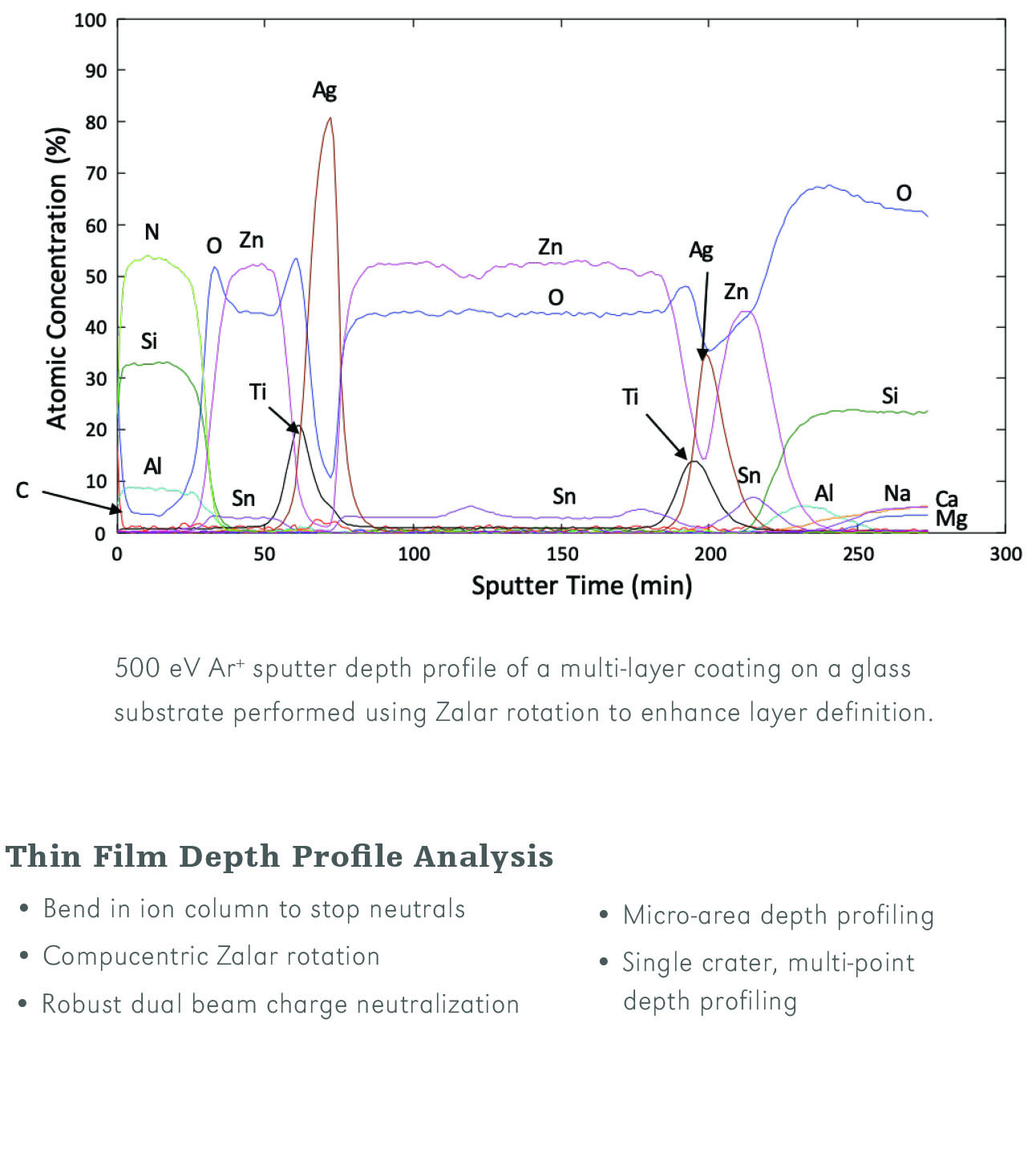
Optimized Configuration
A focused X-ray beam, high sensitivity spectrometer, high performance floating column argon ion gun, turnkey dual beam charge neutralization, compucentric Zalar™ rotation, and advanced data reduction algorithms provide the highest performance XPS depth profiling capability available. The standard monatomic argon ion gun is capable of generating 5 eV to 5 keV Ar ion beams and is ideally suited for most inorganic depth profiling applications.
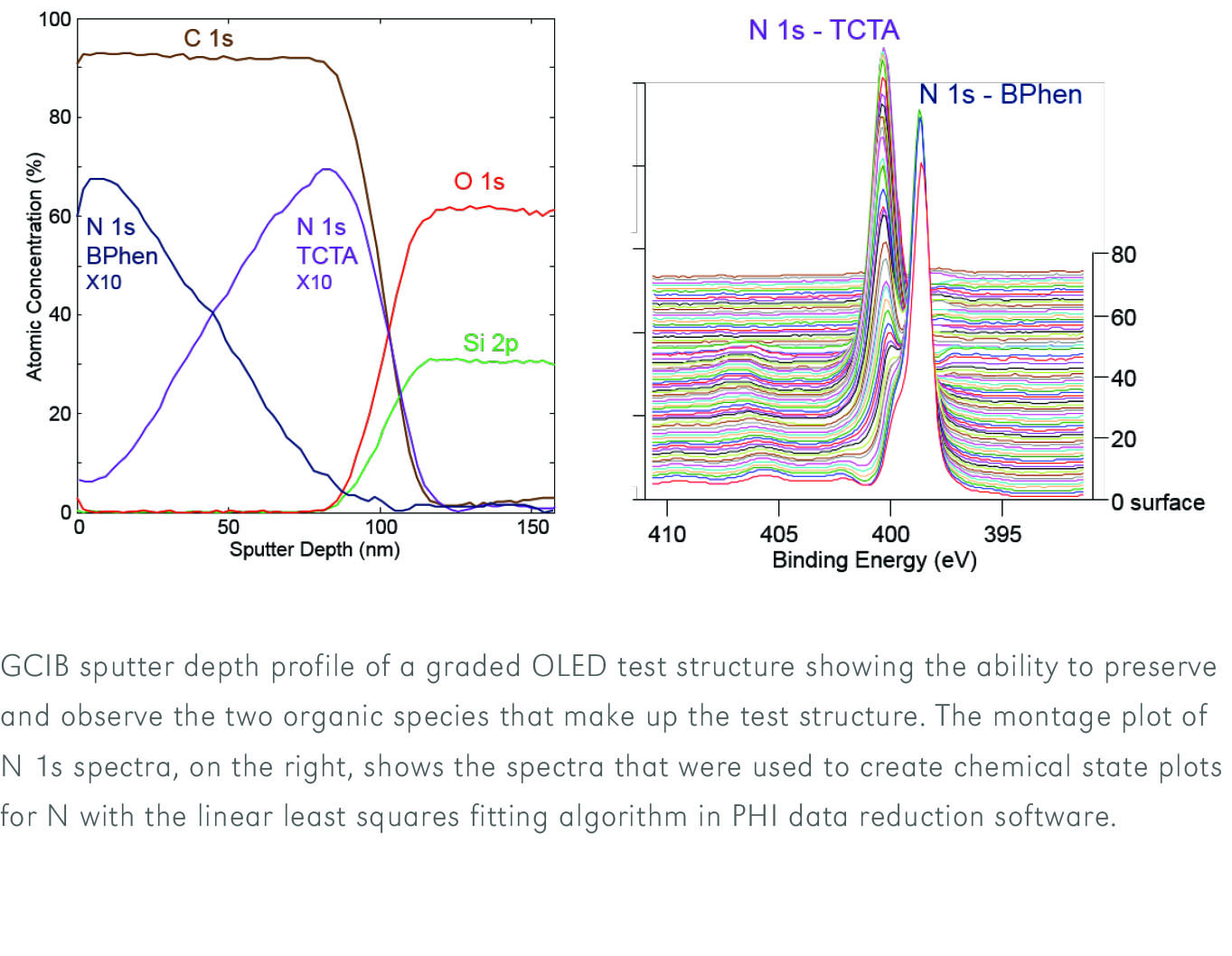
Argon Gas Cluster Ion Beam (GCIB) Option for Organic Depth Profiling
A focused X-ray beam, high sensitivity spectrometer, high performance floating column argon ion gun, turnkey dual beam charge neutralization, compucentric Zalar™ rotation, and advanced data reduction algorithms provide the highest performance XPS depth profiling capability available. The standard monatomic argon ion gun is capable of generating 5 eV to 5 keV Ar ion beams and is ideally suited for most inorganic depth profiling applications.

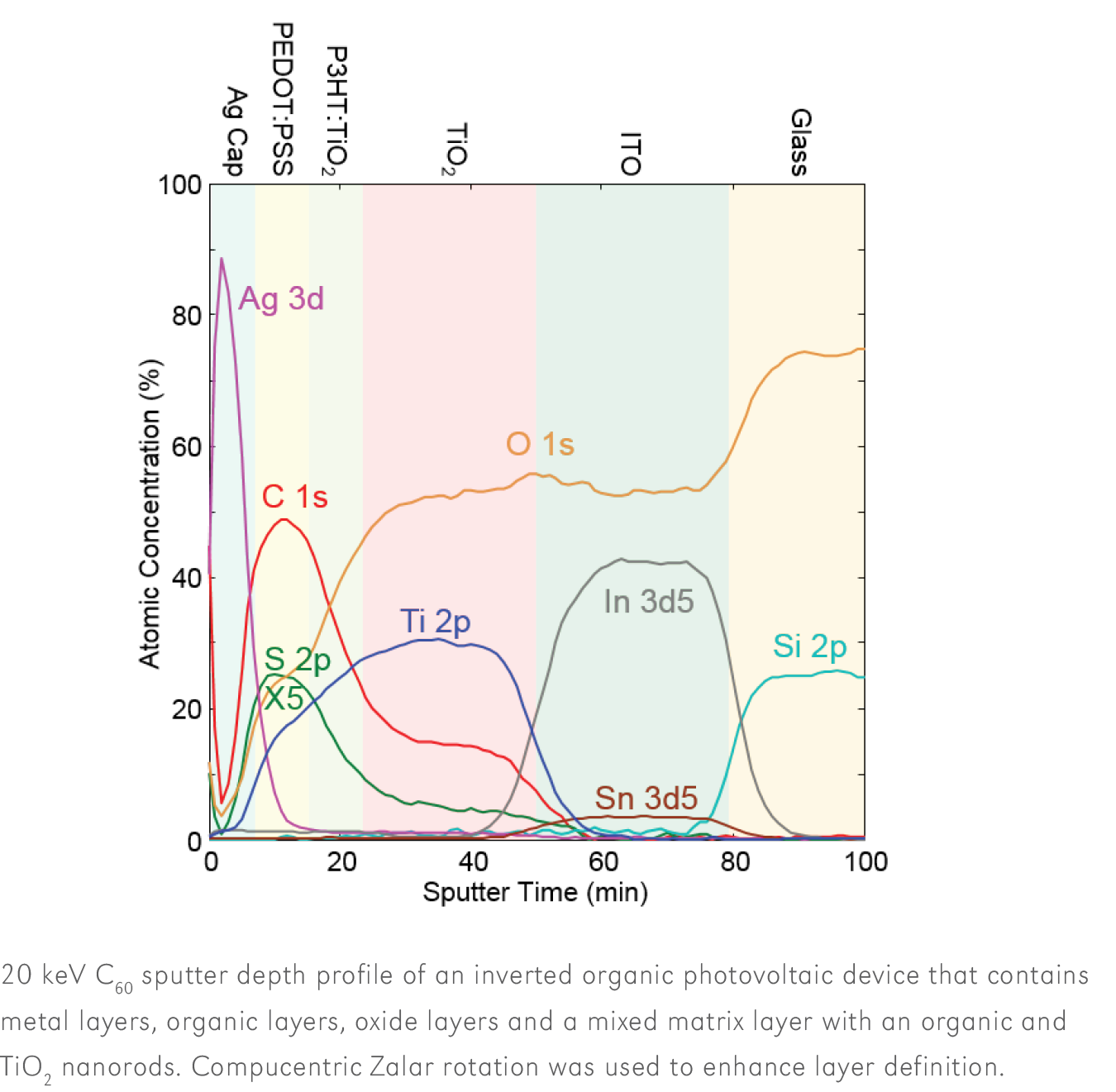
C60 Cluster Source Ion Gun Option for Mixed Matrix Depth Profiling
With the introduction of cluster source ion guns for organic and polymer thin film depth profiling, interest has grown in applying these ion guns to inorganic structures that sustain chemical damage with monatomic Ar ion beam sputtering. Our experience has shown that some metalloids, oxides, and thin film structures that contain both organic and inorganic materials sustain less chemical damage and differential sputtering artifacts when depth profiled using a 20 kV C60 cluster source ion gun.
Multi-Point Auger Spectroscopy & Elemental Mapping

- The convergence of the optical, SXI, and SEM images allows for an intuitive approach to identifying regions of interest for analysis
- Fully integrated user interface for in-situ analysis using both techniques at the same region of interest without moving sample
- Multipoint surveys and high-resolution spectra
- Multipoint sputter depth profiles
- Compositional mapping
- Image registration for image drift correction during the prolonged analysis
- High spatial and energy resolution analysis
- NEW! Dual-beam charge-neutralization
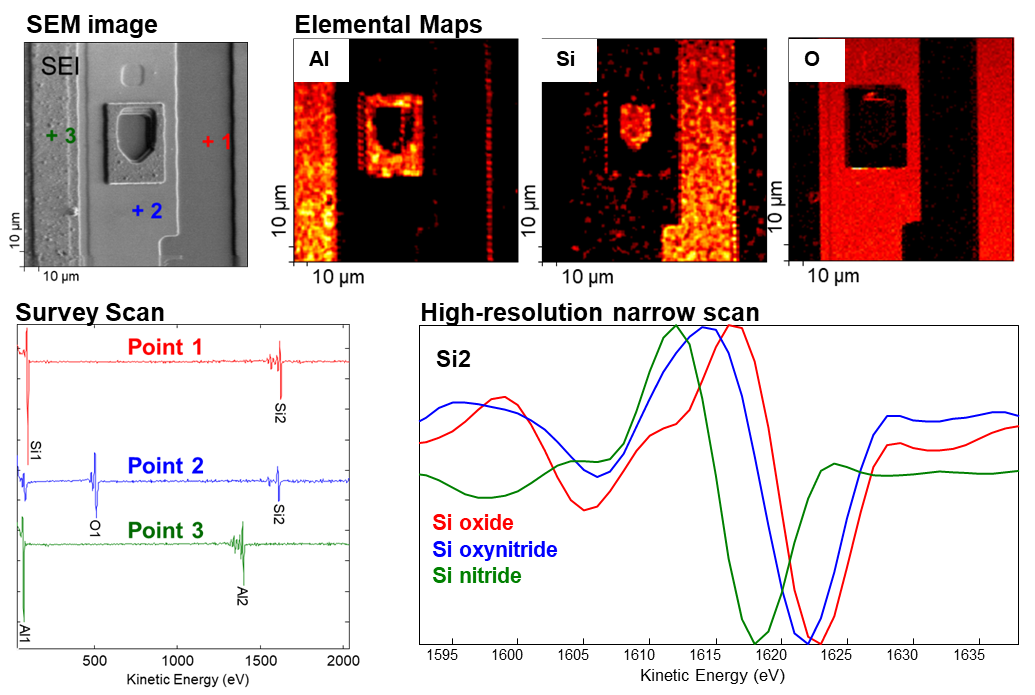
Dual Beam Charge Neutralization for Auger

Complete Electronic Band Structure Characterization
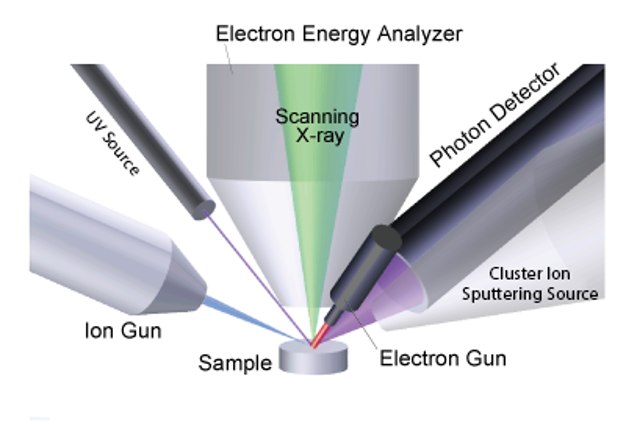
Measurement at the Same Location for XPS, UPS, LEIPS and REELS
In the PHI VersaProbe 4, LEIPS, UPS, Argon and GCIB ion beams, and neutralization beams are all aligned to the XPS measurement position. This allows for comprehensive evaluation of organic semiconductor materials.
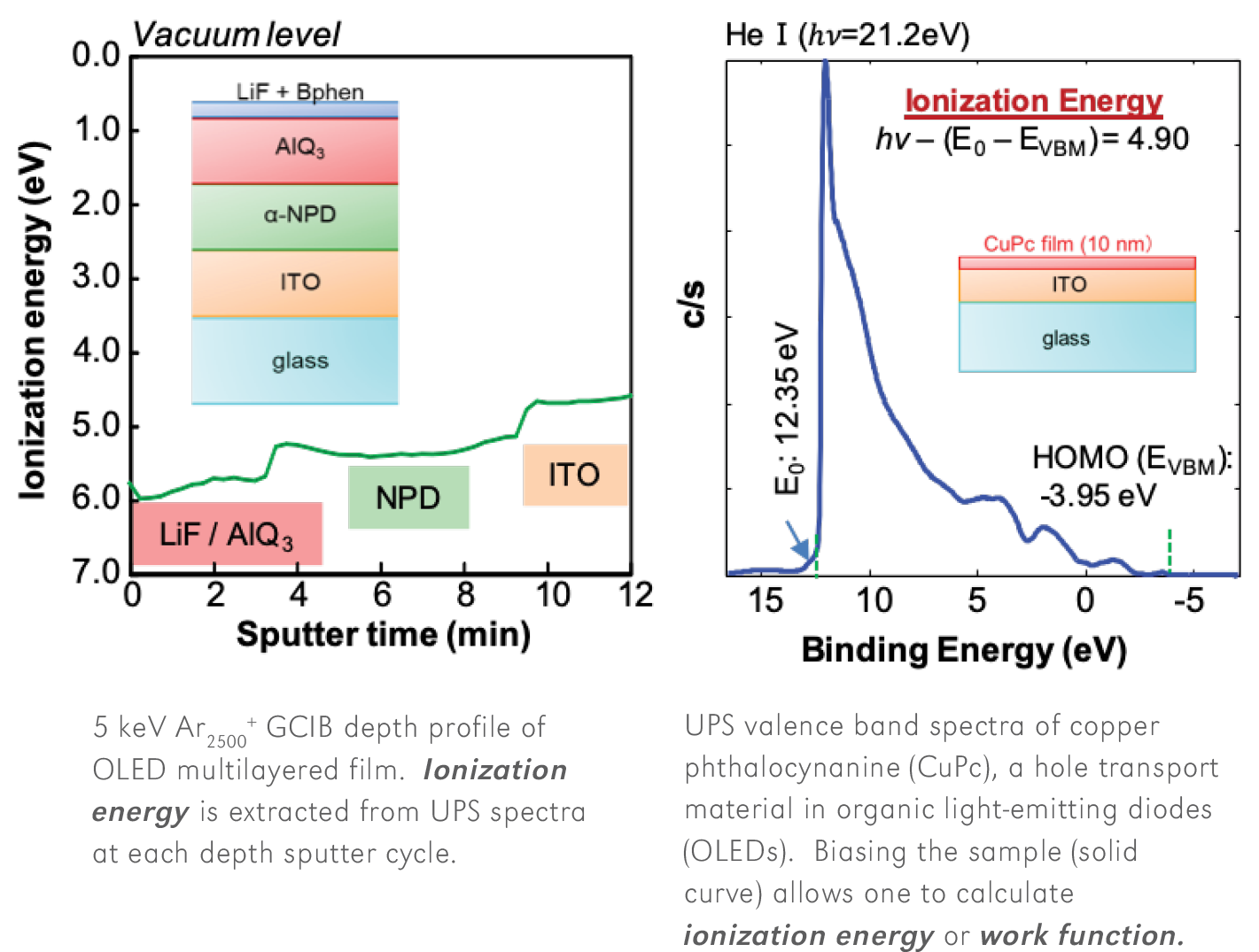
Ultraviolet Photoelectron Spectroscopy (UPS) - Valence Band
Design of complex electronic material systems for display panels, flexible circuitry, and photovoltaics require knowledge of the basic properties of each component’s band structure in order to achieve efficient charge transport.
The combination of ultraviolet photoelectron spectroscopy (UPS) and low energy inverse photoemission spectroscopy (LEIPS) provides a complete characterization of the valence and conduction bands, as well as useful parameters such as the band gap, ionization energy, work function, and electron affinity.
Samples provided by: Organic Optoelectronics Practical Development Center(i3-opera)

Combined measurements from UPS and LEIPS
LEIPS provides accurate values of electron affinity (EA) which is required for designing organic light-emitting diode, understanding band structure at metal-semiconductor and heterojunctions and in studies of charge-transfer processes.semiconductor.
Low energy incident electrons (<5 eV) used in this technique are well-suited for analysis of organic materials with minimal damage.
The ionization energy can be obtained from the highest occupied molecular orbital (HOMO) of the UPS measurement. The electron affinity can be obtained from the lowest unoccupied molecular orbital (LUMO) of the LEIPS measurement. From the difference in those two values, the semiconductor bandgap energy can be calculated.
Combined measurements from UPS and LEIPS
- LEIPS is the inverse process of XPS/UPS
- A sample is irradiated with low energy (< 5 eV) electrons. Photons are emitted from the sample as electrons fill unoccupied states in the conduction band. Photon flux at fixed energy is measured relative to incident electron energy.
- Information obtained from LEIPS:
- Obtain information on the unoccupied electronic energy levels
- Measurement of the electron affinity of the sample
| Item | LEIPS | A Conventional
Inverse Photoemission Spectroscopy |
| Analysis positions |
Same position as XPS, UPS, Ar/C60/GCIB ion guns, and AES/REELS | For dedicated IPES tool, sample transport required for XPS analysis |
| Energy or electrons |
≤ 5 eV Near ultraviolet Low Damage to organic material |
10 eV Vacuum ultraviolet Heavy sample damage |
| Selection of photon energy | Bandpass filter can be changed outside of bell jar | Bandpass filter is in an ultra-high vacuum chamber, difficult to replace |
| Energy Resolution |
≤ 0.45 eV |
0.6 eV |
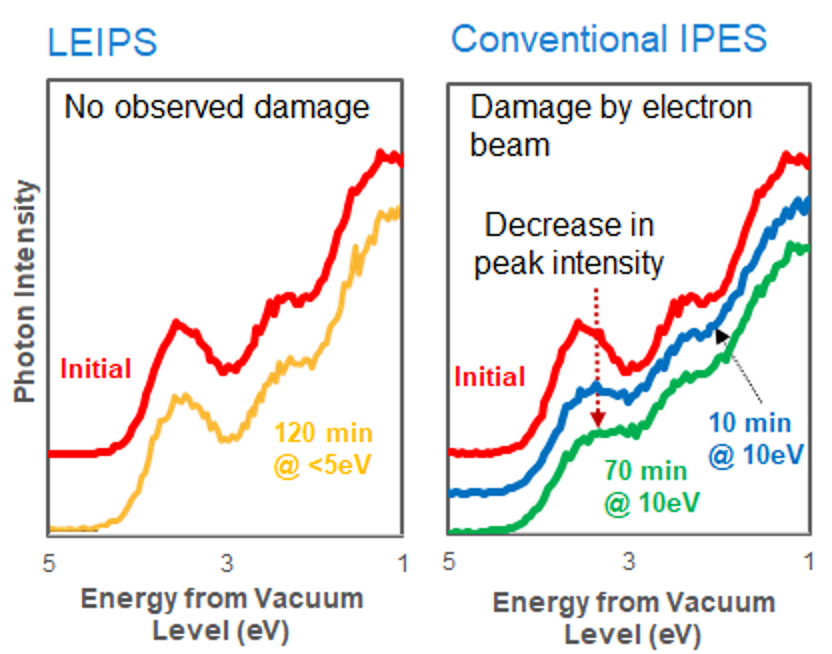
Low Damage Analysis of Organic Matter
A comparison of the degree of electron beam damage on a thin film C60 sample using LEIPS electron energies and conventional IPES energies is shown. When the sample was irradiated with 10 eV electrons, equivalent to conventional IPES, the spectral shape changed, indicating that electronic damage had occurred. On the other hand, in the LEIPS measurement using 5 eV of electron energy, there is no change in the spectrum after extensive measurement time, suggesting that no sample damage has occurred.
NEW!! Smart mosaic for Large Area SXIs and Mapping
X-ray induced Secondary Electron Imaging (SXI) for large-area navigation
- Automated image stitching
- Ability to load stitched image to SmartSoft for positioning
- Create large-area SXI image find/locate features
Fast, easy-to-use method to extend the capabilities of chemical maps over larger size ranges
- Automated image stitching
- Mapping sputter craters

REELS
REELS is a surface analysis technique in which a specimen is bombarded with an electron beam (≤ 1500 eV) and the energy distribution of the reflected electrons is measured. This energy distribution contains features corresponding to discrete losses of the energy of the reflected electrons due to excited atomic states, valence band transitions and material bandgaps.
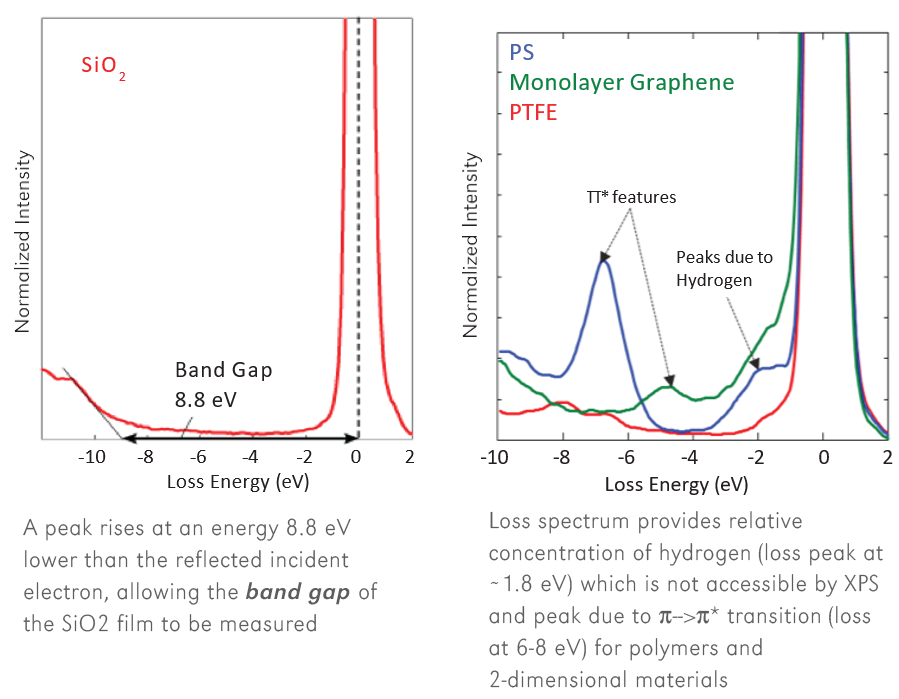
REELS capabilities
- Electronic state and bonding state of the surface
- Bandgap measurement of semiconductors
- Compare the relative hydrogen content of materials
- Observe evidence of conjugation/aromaticity in materials
- Discrimination of sp2 / sp3 bond of carbon
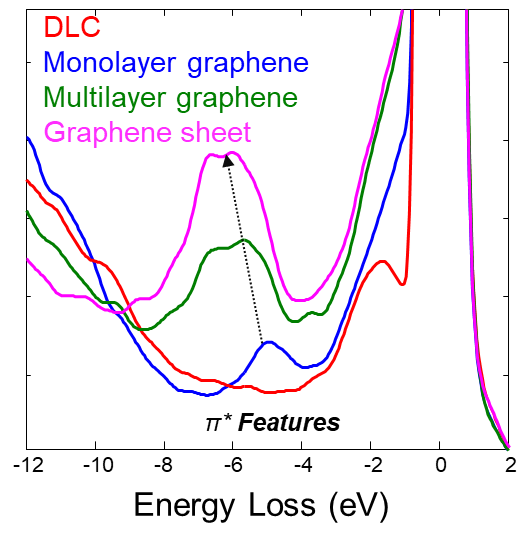
Hydridization Measurements by REELS for 2D materials
REELS is sensitive to the hybridization of carbon. Energy loss peak due to π-->π* transition in graphene appears 6-8 eV lower than the elastic peak.
Intensity of peak increases for higher sp2 character of carbon
Features of REELS
REELS measurement can be made by selecting one of the two electron guns as an option of PHI VersaProbe III. Both electron guns can perform REELS measurement with high energy resolution of 0.5 eV or less according to FAT mode (constant energy resolution).
The first option for REELS is to get the "add-on" for the AES option by using the LAB6 electron gun as the source of energy. If the AES option is not available on your system, then second option for REELS is a newly developed, low-cost electron gun with a tungsten source is available.
Fully Integrated Multi-Technique System with Optional Accessories
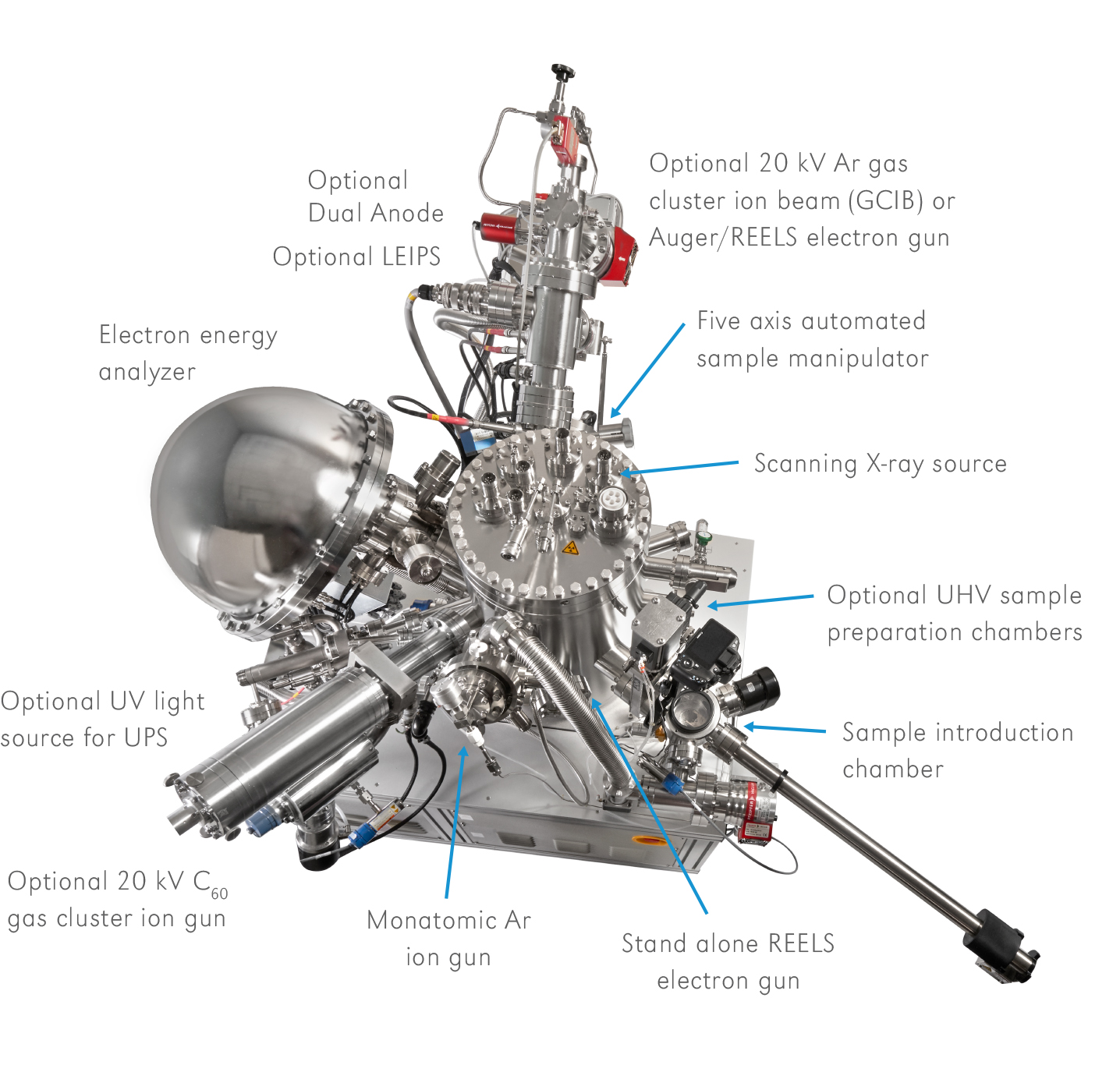
Versatile Test Chamber Configuration
Integrated Optional AccessoriesPHI VersaProbe 4 test chamber is designed to accept multiple photon and ion sources that are focused at a common point on the sample and controlled from the SmartSoft-VersaProbe user interface.
- 1) Scanning x-ray source
- 2) Sample introduction chamber Optional intro/prep chamber
- 3) Argon sputter ion gun
- 4) Electron energy analyzer
- 5) Optical Microscope
- 6A) Five axis automated sample manipulator Optional hot / cold version shown
- 6B) LN2 dewar for sample cooling
- 7) Optional sample preparation chambers
- 8) Optional C60 sputter ion gun
- 9) Optional UV light source for UPS
- 10) Optional dual anode x-ray source
- 11) Optional electron gun for SAM
- 12) Optional 20 kV Ar2500+ gas cluster ion gun
MultiPak Data Reduction Software
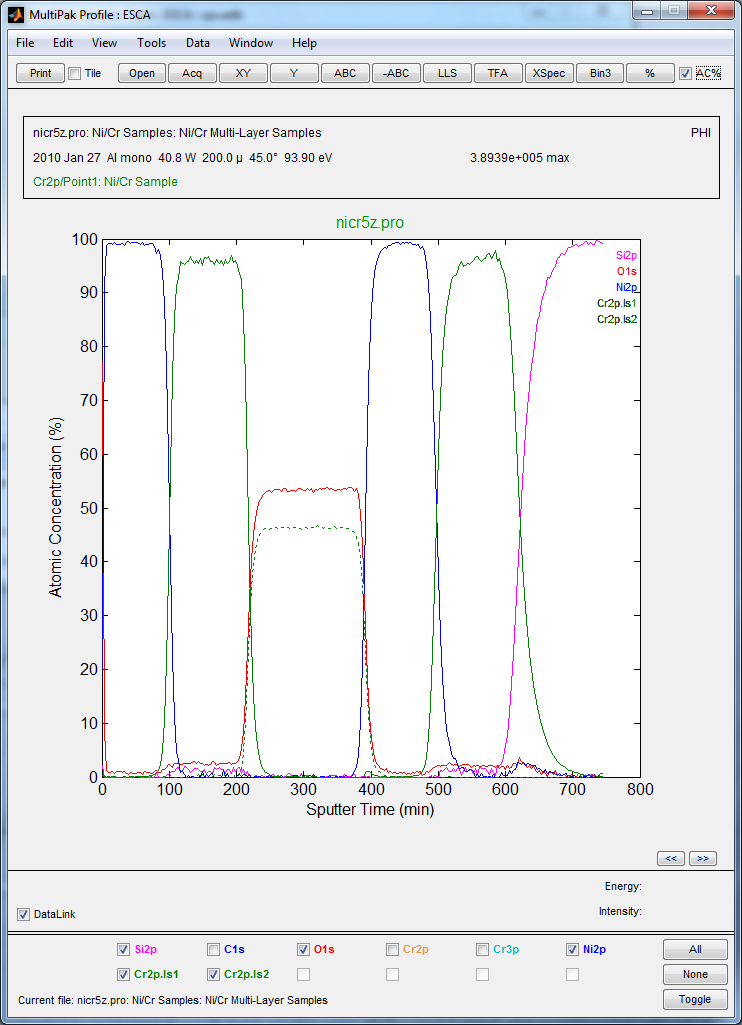
Data Reduction for XPS and AES
PHI MultiPak is the most comprehensive data reduction and interpretation software package available for electron spectroscopy. The tasks of spectral peak identification, extracting chemical state information, quantification, and detection limit enhancement are addressed with an array of powerful and easy-to-use software tools for spectra, line scans, images and sputter depth profiles. MultiPak can be used on the instrument PC to process data in real time or on an off line PC for report generation.
Advanced Data Reduction Tools
- Auto peak identification
- XPS chemical state database
- XPS spectral deconvolution
- Quantitative analysis
- Non-linear least squares fitting
- Linear least squares fitting
- Target factor analysis
- Retrospective chemical imaging
- Batch mode data processing
Brochures
Application Notes
What Our Customers Say.
“The PHI Genesis X-ray Photoelectron Spectroscopy (XPS) instrument has revolutionized our lab's capabilities. Its advanced features and flexibility enable detailed surface material analysis, while PHI's exceptional support ensures smooth operations. The seamless installation and insightful training provided by PHI's knowledgeable field engineers have made this system an invaluable addition to our facilities.”
Quantum Valley Ideas Lab
“PHI's service team is exceptional. Their engineers are professional, reliable, and knowledgeable, always seeking help when needed to ensure reliability. The scientists are equally impressive, providing clear guidance for analysis. PHI's customer service is amazing.”
NY CREATES
“As a global supplier in the automotive, aerospace, and industrial markets, we rely on PHI Auger instruments for customer support, production, and R&D. The PHI 710 Auger, with its state-of-the-art capabilities and excellent customer support, continues to drive our product and process development. The expertise of PHI's service engineers and scientists, along with the flexibility to add specific capabilities, strengthens our long-standing relationship with PHI.”
Manufacturing Customer
“PHI's prompt and willing responses to our VersaProbe system and data analysis concerns have been invaluable. Their excellent application support ensures we always have the help we need.”
University of Virginia
“PHI's TOF-SIMS studies were instrumental in resolving a major issue in our products. Their expertise helped us identify the compromised film, enabling us to successfully address the problem. PHI's support was a significant contributor to our success.”
Semiconductor Contract Customer
Previous Next“We are very pleased with the timely assistance our users have received from PHI's application department over the past six years. The experienced application scientists provide invaluable tips and share application materials promptly, often on the same day. PHI's support has been crucial in expanding our user base and exploring new applications on the system.”
Seagate
Learn how our instruments can help with your applications
